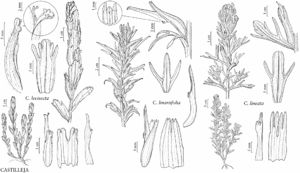Castilleja levisecta
Bot. Gaz. 25: 268. 1898. (as Castilleia)
Herbs, perennial, 1–5 dm; from a woody caudex; with a taproot. Stems few to many, erect, ± decumbent or creeping at base, unbranched, sometimes branched, hairs spreading, medium length and long, soft, mixed with short stipitate-glandular ones. Leaves green to purple or brown-tinged, linear-lanceolate proximally, oblong-ovate or -obovate distally, 0.8–5.2 cm, not fleshy, margins plane, distalmost sometimes ± wavy, involute, 3–7(–11)-lobed, apex obtuse; lobes erect to ascending, linear to linear-spatulate, very short, toothlike, usually arising from distal 1/3 of blade, apex rounded. Inflorescences 2.5–25 × 1–4 cm; bracts bright yellow throughout, or proximally greenish, distally bright yellow, sometimes deep yellow-orange, especially with age, oblong, elliptic, or obtuse to ovate, (0–)5–9(–13)-lobed, sometimes wavy-margined; lobes erect to ascending, oblong, short to medium length, arising above mid length, central lobe apex rounded, lateral ones rounded to acute. Calyces distally yellow, 13–22 mm; abaxial and adaxial clefts 4–9.5 mm, 30–40% of calyx length, deeper than laterals, lateral 2.5–4.5 mm, ca. 25% of calyx length; lobes linear to narrowly oblong or narrowly lanceolate, apex obtuse, sometimes rounded to acute. Corollas straight or slightly curved, 17–28 mm; tube 12–15 mm; beak exserted, adaxially green or greenish yellow, 6–8 mm; abaxial lip yellow or greenish, reduced, not inflated, 2–3 mm, 25–33(–50)% as long as beak; teeth ascending to erect, yellow, 0.5–1.5 mm. 2n = 24.
Phenology: Flowering Apr–Jul(–Sep).
Habitat: Dry meadows, upland prairie remnants, sunny headlands and coastal bluffs, rocky islands, often over glacial outwash or deposits.
Elevation: 0–400 m.
Distribution
B.C., Oreg., Wash.
Discussion
Castilleja levisecta is listed as threatened in the United States and endangered in Canada, where it is extremely rare. Most of its grassland habitat has been altered by development in the Puget Trough, and there are historical stations in the metro areas of what are now Victoria, Portland, and Seattle. For several decades, C. levisecta was considered extirpated from Oregon. However, recent reintroduction programs in Oregon and Washington have been very successful at reestablishing this species at several sites in the Willamette Valley. The bright yellow inflorescences often gradually age to a golden yellow color, unique in the genus.
Castilleja levisecta is in the Center for Plant Conservation’s National Collection of Endangered Plants.
Selected References
None.
